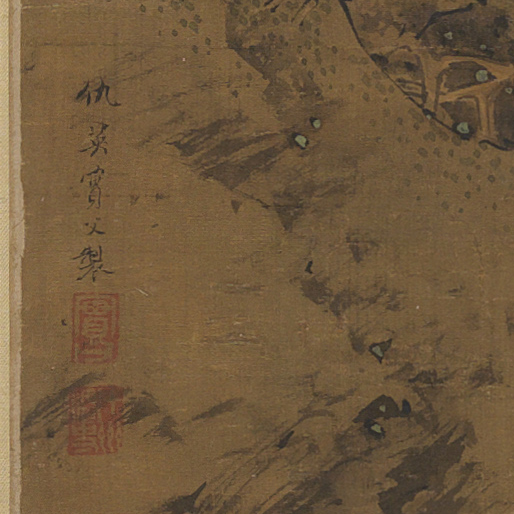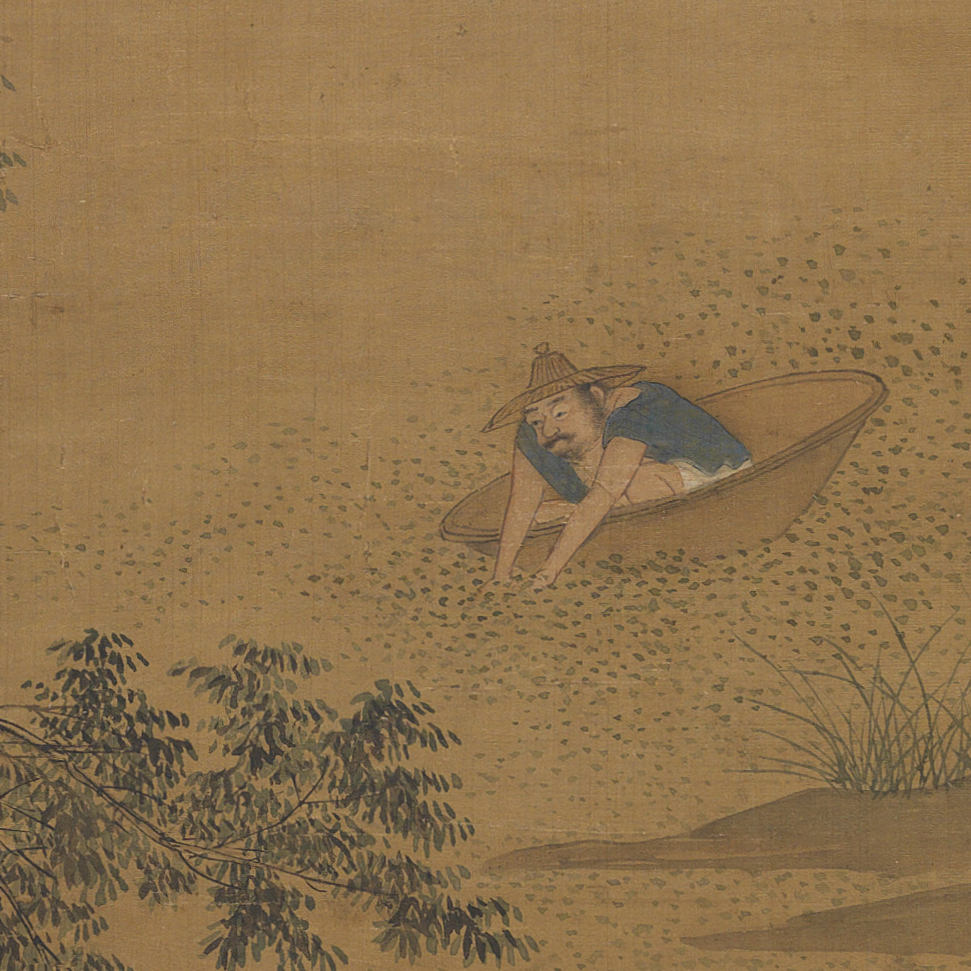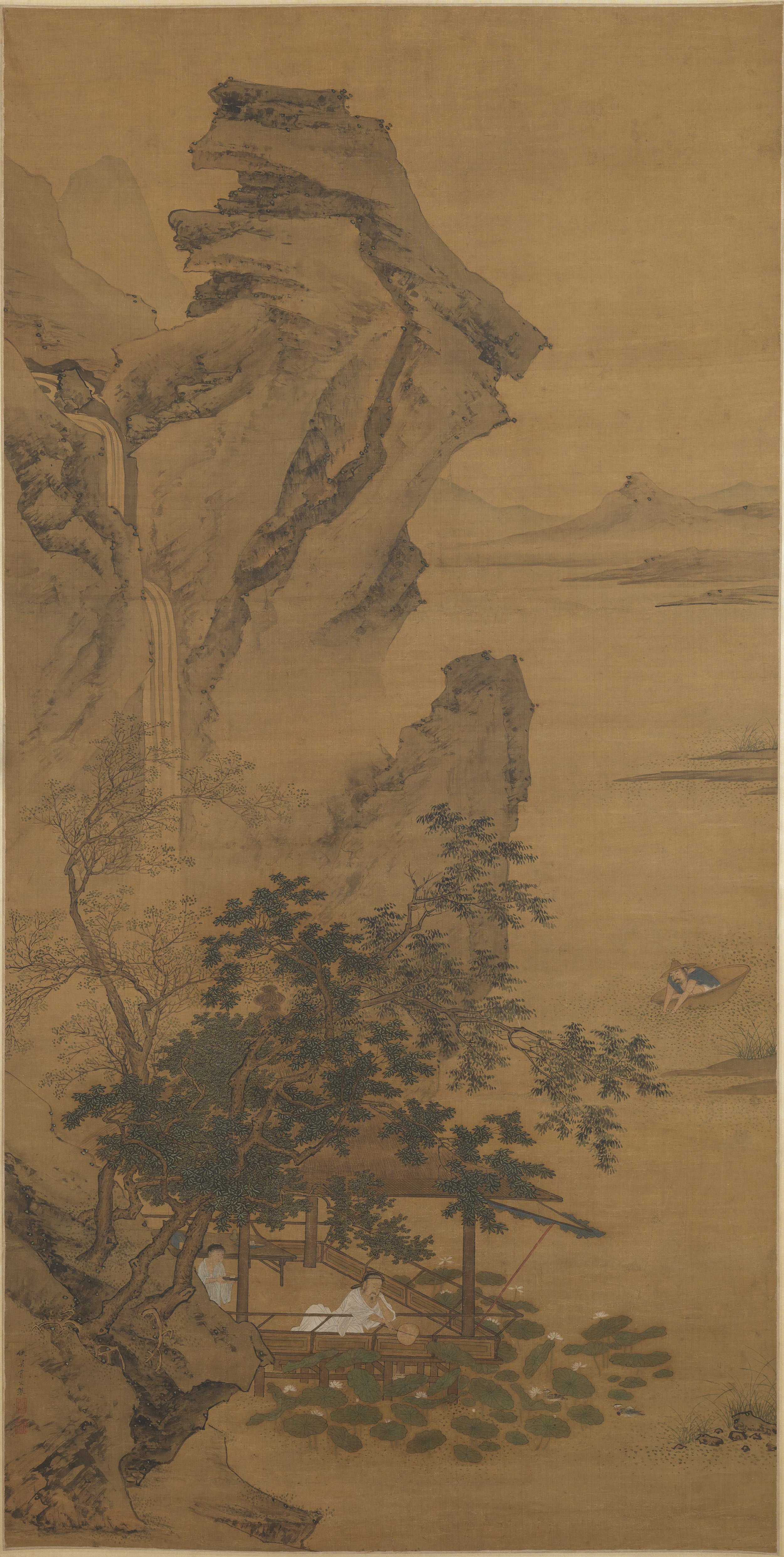Qiu Ying 仇英 (c.1495-1552)
A hanging scroll in ink and colours on silk, Zhou Dunyi looking out over lotus, circa 1530s.
A scholar sits at his leisure, leaning on the rails of his lakeside pavilion and staring pensively out over a cluster of lotus flowers and large leaves, a pair of mandarin ducks swimming amongst them. In the summer heat, the pavilion’s awning is propped outward, and further shade is afforded by a clump of four variegated trees growing at an angle from the rocky foreground. The scholar wears a loose cotton robe, two-dimensionally linear, and an old-fashioned transparent gauze cap, cleverly depicted with his fine hair detailed. He holds a stiff fan listlessly as his young attendant brings a cooling cup of tea on a tray. On the table are a dish of fruit or bean curd, a six-juan book in its wrappers and an empty Song dynasty Guanyao vase. Just behind the pavilion a waterfall drops precipitously, providing a background hum of babble to his reverie, while the dramatic diagonal thrust of a splendid Li Tang-style mountainous outcrop forcefully dominates the serenity of the scene. Off to the right a solitary fisherman out scooping waterweed in his coracle delightfully points up with his intrusion into it the studied refinement of this carefully constructed idyll. His humorous, crudely bulbous features contrast nicely with the fine sensitivity of the scholar, whom we identify as the Song thinker Zhou Dunyi (1017-1073).
Painted area: 116 x 58 cm (45 3/4 x 22 7/8 inches). The fine old window mount incorporates a superior Ming brocade to its upper exterior.
Signed: Qiu Ying Shifu zhi, with two intaglio seals of the artist: Shifu and Shizhou xianshi. The latter is an unusual variant; but Qiu signed a fan in the Asian Art Museum, San Francisco, with the art name Shizhou waishi, and elements of the signature compare well with other known works. The left ‘man’ radical of the Qiu surname has a characteristically strongly diagonal slant, while the ‘grass’ radical element of Ying has two separate horizontal strokes, rather than one continuous line. Based on the style of the painting, and the use of the artist's rare seal Shizhou xianshi, which appears on an album leaf in the Palace Museum, Beijing, Mingfei Passing the Frontier, part of a ten-leaf set of copies after Song and Yuan fan paintings simply entitled Album of Figure Paintings, and Qiu’s Hunting on an Autumn Plain hanging scroll in the Liu Haisu Museum, Shanghai, which can itself be directly tied to the period during which Qiu enjoyed the patronage of Zhou Fenglai (1523-1555) - a decade or so considered to be Qiu Ying's middle period - it can be dated to circa 1530-1542.
Qiu Ying, zi: Shifu, hao: Shizhou, was born and died in Taicang, Jiangsu, but spent most of his working life in Suzhou. From a humble family, in early adulthood he went to study under the Suzhou painter Zhou Chen (1450 - ca 1535), who also taught Tang Yin. Qiu stayed with Zhou from as early as 1517 until about 1530-31, when his talent became widely recognised. One of the Ming dynasty’s most accomplished, versatile painters, he has been regarded since the late sixteenth century, with Shen Zhou, Wen Zhengming and Tang Yin, as one of the Four Masters of the Wu School; more commonly, the Four Great Masters of the Ming.
Published: Sydney L. Moss Ltd., "Between Heaven And Earth", 1988, no. 6.
Ex collection: Ed and Mary Meader, Kalamazoo MI.




